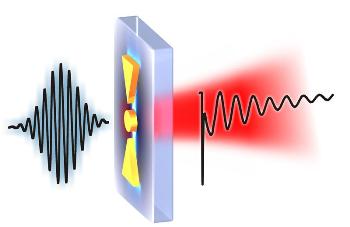Minute gold nanoparticles with 40 millionth of a mm diameter, when focused by a short laser pulse, gets heated up and begins to vibrate. It is challenging to study these minute nanoparticles because even highly efficient microscopes do not have the resolution to study them.
 The principle of nanoantenna: The triangular nanoantennas focus the laser light on the small gold dot in the center, which starts to oscillate and to modulate the transmitted laser beam.
The principle of nanoantenna: The triangular nanoantennas focus the laser light on the small gold dot in the center, which starts to oscillate and to modulate the transmitted laser beam.
The assistant professor of the Max Planck Institute for Solid State Research, Markus Lippitz, worked in collaboration with Thorsten Schumacher, his student, to study these nanoparticles and their findings were published in the Nature Communications journal. They made use of a nano-antenna which had already been used as a nanosensor. The sensor was a creation of Prof. Harald Giessen who belongs to the University of Stuttgart’s Physics Institute.
It is possible to determine the characteristics of nano-gold by studying its oscillations. Scientists must understand if nano-gold vibrates like a balloon or like a piece of steel and if its performance is affected by the surface. The research that involves analyzing the vibrations of nanoparticles is called nano-mechanics. His laboratory features a complex experimental system consisting of nanoparticles, mirrors, and lasers. The optical setup in his lab enables scientists to observe the oscillations using a strobe light. Dr. Lippitz has established a method to study these fine oscillations.
Dr Lippitz, an assistant professor of the University of Stuttgart hopes to study the mechanical properties of nanoparticles of the smallest dimension. For the experiment, he positioned a small antenna adjacent to the minute particle. This nano-antenna concentrates the laser beam accurately on the nanoparticle under study. The nanomechanical vibrations caused modulation of light, which was efficiently coupled back into the laser beam. Lippitz explains that this is the first time nano-antennas have been used to study ultrafast nonlinear optical effects. He feels that due to this discovery it will be possible to study the tiniest nanoparticle in the focal point of a nano-antenna using non-linear optical techniques of just a few femtoseconds duration. It will be possible to take nano-scale movies and observe quantum dots, molecules and viruses.